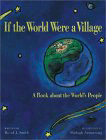If the World Were a Village

by David J. Smith, Illustrated by Shelagh Armstrong
32 pages,
ISBN: 1550747797
Post Your Opinion | | Children's Books
by Deborah Wandell
Big numbers boggle our brains. How then to write a children's book that dares to use population figures to talk about the world's people? Through the clever strategy of making 1 person stand for 62 million people, author David J. Smith neatly sidesteps our collective mental block when confronted by rows of numbing 000s. This allows him to create a village of 100 people, and show the ways they can be differently grouped and divided according to such categories as religion, language, nationality and their unequal access to resources such as food, water, electricity and clean air. What is lost in numerical precision is gained in comprehensiveness and clear comparisons.
If the World were a Village provides challenging information for readers of any age. Our North American perspective may be jolted by the fact that 22 people in this 100-person village speak a Chinese dialect, 8 speak Hindi, while Arabic and Bengali speakers each make up 4% of the population. Only 9 people speak English. Under religious beliefs, we learn that 19 people follow Islam, 13 are Hindu, and 12 practice folk religions: the presence of 32 Christians in this village alert the reader to the legacies of colonization. In fact, it quickly becomes clear that all these statistics speak volumes about the world's political and economic history over the past 500 years, with many acting as stark indicators of current global inequities. Under æFood', we learn that 60 people are always hungry, of whom 26 are severely undernourished. A further 16 people are occasionally hungry.
But statistics can be deceptive. Smith's handling of the data on money and possessions seriously obscures global realities. He starts with what seems a "fair" premiseùthat the equal distribution of the world's wealth would give each person an average annual income of $6,200. According to this global averaging, the richest 20 people currently have over $9,000 a year, while the poorest 20 have less than $1 a day. But this is an income differential of just 30:1, which we see daily on the streets of most Canadian cities, where people with $250,000 per annum incomes regularly rub shoulders with those making under $8,000 a year on social assistance. The problem is that Smith's averaging dangerously smooths out the truly vast gaps between the rich and the poor that exist globally, especially between North Americans and people in developing countries. The further assumption that each person requires $5,000 for basic needs also cancels out all distinctions between way of life in subsistence and post-industrial economies. These are not unimportant differences, as we shall see.
The deeper problems with this book have to do with sins of omission. I found myself wondering what well-intentioned parents and teachers will be able to do with all this data. Sometimes, the facts read suspiciously like soundbites: shocking and disturbing, but finally not illuminating. Unfortunately, it is not just big numbers that confound us. As a society, we are notoriously innumerate, unable to unpack and analyze statistics so we can æread' what they are telling us: what does not having electricity have to do with being unschooled, with having no clean water, with having many children? While the author took on the commendable and daunting cause of organizing and presenting statistical data about the world's people for younger readers, he neglected the corollary obligation to draw out the causal links and correlations amongst these discrete bits of information. The legitimacy bestowed on statistics makes it all the more critical that we ask what these statistics mean. How does all this data reflect our values, our neighbourly/global relationships, our very ways of life? Smith does not help us connect the dots.
However, the author's analysis emerges, obliquely and disturbingly, through the book's structure. What are we to infer from the fact that the author devotes his first two pages to the numbers of people living on the world's continents and in the world's most populous countries (all without mentioning relative land masses), and the last two pages to the increasing rates of population growth since 1000 B.C.E, which the author finds worrisome? With these statistics on population growth as the bookends of the text, the coverage of issues such as unclean air and water, shortages of food and money, is quite literally framed as a problem of overpopulation.
Most disturbing is the fact that Smith, when worrying over impending resource shortages, never mentions the fact that our North American post-industrial way of life could be adopted around the globe only if 5 more Planet Earths were available for spare parts. The book leaves unexplored the premise that some people might actually use too much of the world's resources, land and labour, and that this overuse is a factor in environmental degradation and global poverty. Instead, Smith's focus illuminates only that there are those who don't have enough. Ultimately, his statistical spotlight obscures as much as it reveals.
Shelagh Armstrong's vibrant acrylic illustrations depict multi-coloured villages nestled in landscapes of greens and blues, reminiscent of the first space photos of Earth which gave us a new sense of Earth's fragility and our responsibility towards it and those with whom we share it. Bicycles, chickens, goats, markets and simple buildings abound, as though the illustrations are also proportional snapshots of how most of the world's people live. Avoiding a universalizing blandness, Shelagh Armstrong has successfully inserted enough details of clothing and architecture that differences are highlighted and celebrated.
Despite the many problems, Smith has broken daunting new ground in organizing statistical material for young readers, giving children, parents and teachers a place to begin discussion. What we need now are more books of this kind, directed at this age level, and hopefully ones that exercise more statistical responsibility.
Deborah Wandell is a passionate reader, gardener and traveler who lives and works in Toronto.
|